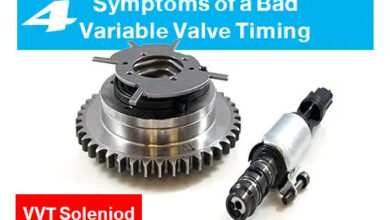The ignition timing method
The ignition timing method
Some general information on the ignition
A battery supplies a voltage of 6 or 12 volts which is insufficient to supply the ignition spark (15,000 volts) required to ignite the air-gasoline mixture. this is often why the battery voltage must be transformed into high voltage within the induction coil . The coil works sort of a transformer: a current flowing through a winding creates a field of magnetic forces. When this magnetic flux cancels out, an inductive voltage forms altogether electrical conductors that are cut by the lines of force of the sector .
The output voltage are often increased by using two windings, one among which has more turns than the opposite . The induction coil consists of an iron core (a bar made from sheet strips) which is surrounded by the secondary coil comprising 15,000 to 30,000 turns of very thin copper wire. Above is that the primary coil with a couple of hundred turns of much larger copper wire.
Two ends of the first winding and therefore the secondary coil are coiled together and terminate at terminal 1 of the induction coil . the opposite end of the first winding ends at terminal 15, while the opposite end of the first winding is that the high voltage terminal 4 connection.
When the switch is closed with the key , the first winding is connected to the positive pole of the battery. When the breaker contact is closed, the present flows from the battery to connection terminal 15 of the induction coil , passes from the first winding to connection terminal 1, from where it flows to the contacts of the induction coil . breaker, of the igniter.
The only moving parts of the ignition are within the igniter, they’re the distributor parts. Contact grains (platinum-plated screws) are switches that stop the present to the first winding of the coil. The distributor finger and igniter cap send high voltage current from the coil to the spark plugs within the order the engine is fired. Each sparking plug produces a spark when the piston reaches the top of compression.
High voltage current flows through a wire from the coil to the middle terminal of the igniter cap. A plastic dispenser finger, which features a metal insert, rotates under the cap. The metal blade remains in touch with the middle terminal of the cap.
The distributor finger is driven by the distributor shaft, itself generally controlled by the camshaft. These organs rotate at an equivalent speed (half that of the crankshaft). Current is shipped to every candle every four strokes. because the revs are increased, the candles should light earlier to permit complete combustion. This adjustment is formed by the ignition advance mechanism.
Capacitor and breaker
Cancellation of the magnetic flux generates a self-induction voltage within the primary coil , which is so high that an arc are often formed on the breaker. Like this phenomenon
would cause strong wear and carbonization of the contact grains (platinum-coated screws), a capacitor was placed within the distributor, which is connected in parallel, to soak up the parasitic sparks. The capacitor acts like an accumulator.
It retains the electricity produced by the formation of the arc between the contacts of the breaker. This energy flows back to the first winding of the coil and promotes the rapid suppression of the magnetic flux , and consequently the build-up of the induced ignition voltage within the secondary coil . Ignition capacitors must be shielded from heat because insulating materials become more conductive on heating.
Adjustment of the ignition point and distributor
On the flywheel or on the pulley, there’s a mark for the ignition setting. the primary step is to crank the engine over until the marks face one another . When this operation is administered , it’s known that the cylinders 1 and 4 are at top dead centre . Again turn the crank in order that there’s a 5mm forward offset with the fixed mark. As a result, an ignition advance of about 6 ° was created.
We must then replace the igniter. to try to to this, it’s necessary to show the cam to make sure that the screwdriver bit engages the notch properly. The input of the breaker is connected to the output of the first winding of the coil.
A pilot light was placed. this is often connected between the input of the breaker and therefore the ground of the car. We put the ignition on. the aim of subsequent manipulation is to softly rotate the igniter body until the lamp lights up. As soon because the lamp shines, we are within the position where an electrical shock producing a spark could ignite the air-fuel mixture in piston 1.
The igniter body is then locked during this position using the igniter tightening jumper, being careful to not move the assembly.
The distributor finger and therefore the cover must then be fitted. Then, we connect all the pads to the corresponding spark plugs (remembering the order of ignition of the spark plugs: 1-3-4-2) and eventually the output of the secondary coil to the central pad of the distributor.
The engine are often started. to enhance its operation, the first circuit are often connected with the EDI box.
Therefore, a really fine adjustment are often made employing a lamp strobe.
The manipulation consists of illuminating the above-mentioned landmarks using the strobe which emits flashes at the frequency of the electrical pulses commanded by the switch. If there was no delay or advance at ignition, we should always observe the rotating guide « frozen » ahead of the fixed guide thanks to retinal persistence. actually , we manage to make a lead . This advance results from the very fact that the ignition of the mixture isn’t instantaneous and must therefore be anticipated during the compression phase. we’ll therefore observe the « frozen » mark slightly to the left of the fixed mark (this corresponds to a spark produced before the piston is at top dead center).
The rest of the manipulation consists in measuring this phase shift (at idle).
We will therefore act on the phase shift of the stroboscope by means of a wheel. hamper the flashes until the marks coincide perfectly. Once this operation has been administered , the phase shift is read directly on the machine.
During the TP session, we also measured the phase shift at different speeds (1600, 3000, 4300 rpm). it’s been observed that the upper the engine speed, the greater the phase shift (i.e. the ignition advance). this is often normal because the pistons go much faster and therefore the entire mixture should be ignited at an equivalent piston position. it had been thus possible to verify that the manufacturer’s data were respected.






